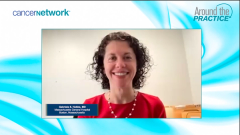
What is the Role of Cytogenetics/Genomics in Myelofibrosis?
Shared insight from a panel of experts on the current state of cytogenetics in myelofibrosis and how it impacts treatment pathways for patients.
Episodes in this series

Transcript:
John O. Mascarenhas, MD: Let’s move on to what I like to call cytogenomics, which is cytogenetics and the genomics of MF [myelofibrosis]. What happens for patients with MF? Are they getting a PCR [polymerase chain reaction] test for a driver mutation? Are they getting next-generation sequencing? Is everyone getting it? How often do you do it? Kristen, when you see patients with MF, what’s your approach in terms of getting genetic data?
Kristen M. Pettit, MD: These diseases are heterogeneous in the clinic as far as how they present and also heterogeneous as far as the outcomes and what happens to patients over time. But 1 thing that’s less heterogeneous is the driver feature of the disease, which is overactivation of JAK-STAT pathway and JAK-STAT signaling. That occurs most commonly through mutations in JAK2, CALR, and MPL, so we’re prognostically always checking for those 3 mutations at baseline. What’s also important is additional somatic mutations that can be present on top of those JAK-STAT activating mutations.
My practice in the clinic is to test for these things initially at the time of diagnosis for all my patients with myelofibrosis. Depending on what’s been done already, sometimes we already know the JAK2, CALR, or MPL status when patients come to us. If we don’t know those already, sometimes I do single-gene PCR tests for those because they can be done quickly in a 3-day turnaround time, and that can help diagnostically. Sometimes it’s important to get those done quickly, but I always send a next-generation sequencing panel as well. There are several very good next-generation sequencing panels. We use an internal panel that we’ve developed and continue to refine that has all the high-risk mutations of interest, including TP53, ASXL1, SSF2, IDH1 and IDH2, and EZH2. That turnaround time tends to be a little longer, so it’s important prognostically to know at baseline but does take a little time to get back. I routinely do that for all my patients with a new diagnosis of myelofibrosis.
As far as serially monitoring over time, that’s an interesting question. It’s yet to be determined how often we should be testing these over time. I always repeat next-generation sequencing if I see a change in the disease behavior. If a patient goes from having a more proliferative myelofibrosis with high white blood cell count, large spleen, and high inflammatory symptom burden, and then develops more cytopenic disease behavior with lower blood counts and more fatigue, then I’m always repeating the next-generation sequencing. I’m looking for changes in the mutation profile as well as any signs of disease progression toward acute leukemia at that point.
John O. Mascarenhas, MD: Excellent. Gabby, can you give some concrete examples of where mutational profiling might have a direct impact on therapeutic decision-making?
Gabriela S. Hobbs, MD: When I first meet a patient in the clinic, I may not have all their information. I do a lot of risk stratification without the mutations, using the DIPSS [Dynamic International Prognostic Scoring System] plus score, for example. Having those molecular markers is important when you first meet a patient so you can risk stratify them. It centers that discussion initially on what to expect for the patient, but it also helps in terms of making the decision of whether this patient should see the transplant docs sooner rather than later. It’s always difficult in practice when you have a patient who may look like they’re lower risk because their counts are OK, but then you do the next-generation sequencing and find a lot of high-risk mutations, like ASXL1, TP53, or others. You may not necessarily act on that immediately, but at least it heightens your awareness about that patient and you may follow that individual more closely and refer them to transplant. For prognostication and referral to transplant, having that additional information is key.
John O. Mascarenhas, MD: Gabby, maybe it’s worth providing some insight on whether the driver mutations help you in deciding the use of a JAK inhibitor. Do they influence that decision?
Gabriela S. Hobbs, MD: At the moment, no. My decision to initiate JAK inhibitor is based primarily on whether that patient has symptoms, either systemic symptoms or symptoms from their spleens. But what driver mutation they have doesn’t influence the decision to use a JAK inhibitor. The additional mutations also don’t factor into that. It definitely factors into saying how I phrase the conversation to patients. I may say, “I’m going to start you on a JAK inhibitor to help with spleen and symptoms. But based on these mutations and your risk profile, regardless of what ends up happening while you’re treated with the JAK inhibitor, the end goal is still to get you to transplant.”
John O. Mascarenhas, MD: When you put someone on a JAK inhibitor, do you do any serial monitoring of that driver mutation? Is there any value in doing that?
Gabriela S. Hobbs, MD: Patients have started asking more for repeat testing of their driver mutations. I don’t do that routinely for myelofibrosis. If there’s a change in the behavior of the disease, if the patient is going to go to transplant, if they’re transforming to leukemia, there’s some value to repeating that testing. But in day-to-day practice, having different levels of those mutations is hard to interpret and also leads to a lot of anxiety. I’ve had patients who look like they’re doing wonderfully on a therapy, and then you check the variant allele fractions and they went up. It’s hard to act on those changes because we still don’t know how to interpret them. Our treatments aren’t made to target those mutations specifically. Even though from studies we see that JAK inhibitors may lead to a decrease in variant allele fraction in JAK2, we still don’t know what to do with that information.
John O. Mascarenhas, MD: I totally agree.
Transcript edited for clarity.
Newsletter
Stay up to date on recent advances in the multidisciplinary approach to cancer.


































































































